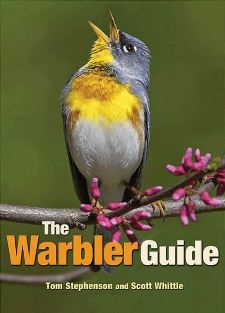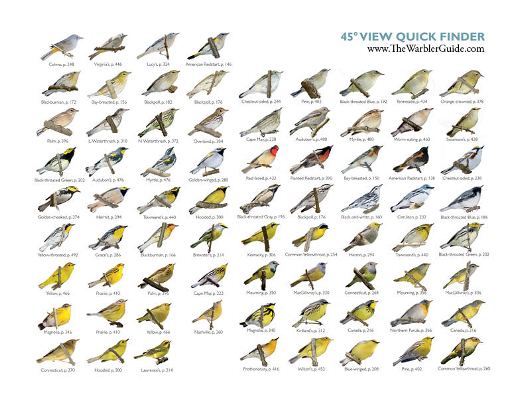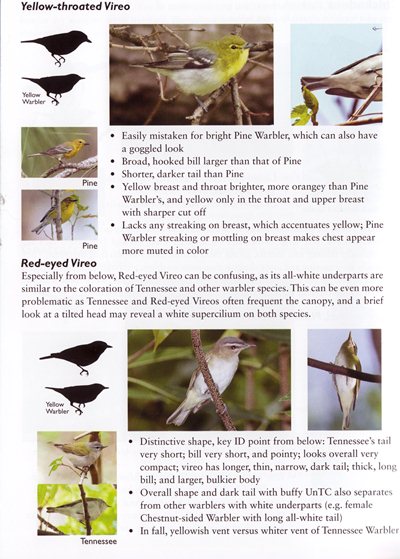Reviewed by Grant McCreary on August 16th, 2013.
On one of my very first ventures as a birder, nearly ten years ago as I write this, I saw a beautiful male Hooded Warbler. I’ve been hooked on warblers ever since. In those early days, I longed to see one every time I donned binoculars. But then after finding one, it was no easy matter to identify it. I often only got a partial view or a quick look because they just wouldn’t stay still! The Sibley Guide was, of course, a great help. But I still needed something else, which I eventually found in the Warblers Peterson guide. That book has served me well, but I’m again at a point where I need something more. After hearing about The Warbler Guide and all of its features, I was hoping it would be what I was looking for.
The Warbler Guide is a photograph-based identification guide to the 55 warblers of the United States and Canada. This is most definitely an identification guide. You won’t find much in the way of natural history information here, except as it pertains to identification. But I’m ok with that, as that info is readily found elsewhere. The identification material here, however, is largely unique to this book.
Species Accounts
I examined the species accounts in detail in my initial review of The Warbler Guide. The more I use it, the more I like these accounts. I think they are just about perfectly tailored for these birds. I appreciate the small, but potentially very helpful, things like the maps showing the full wintering range of these migratory birds, and that subspecies ranges are labeled where appropriate (or given their own maps!).
But perhaps the best, and certainly the most unique, thing about the accounts is the treatment of vocalizations. As mentioned in my initial review, there are many, many sonograms. By themselves they would be of little value, but when you combine them with the authors’ excellent, clear analysis and the accompanying audio tracks you have a unique, innovative system for learning warbler sounds. (Although, I understand that Nathan Pieplow of Earbirding.com is using a similar system in his upcoming guides to the sounds of North American birds.) For more details on how this vocalization system works, I recommend watching this video or reading this post on 10,000 Birds.
However, the accounts aren’t quite perfect. My main issue with them is the small size of some photos. Most of the images are fine, but the “additional photos” can be pretty tiny. Additionally, the accounts for some dimorphic species – like Hooded and Yellow-rumped – include both forms on the account’s first page, with one being shown smaller. Invariably, it is the female that is shown in the smaller photo (or in the Yellow-rumped’s case, the Audubon’s form). Some users may have trouble seeing these pictures well enough.
Introduction
The photo-filled behemoth of an introduction is just shy of 100 pages. It has the requisite sections on how to use the book and bird topography (very well done). But the bulk of it deals with the basics of warbler identification. Newer birders would be well advised to read “What to Notice on a Warbler”. This extensively illustrated section tells you what to look for on warblers, from face to tail, and other things that you should note, such as habitat and behavior. And if you want to learn warbler songs, the chapters on “Understanding Sonograms” and “How to Listen to Warbler Songs” are extremely helpful. Then, if you’re particularly ambitious, there’s “Learning Chip and Flight Calls”.
Other Features
But that’s not nearly all that The Warbler Guide offers. What’s destined to be the most-used feature is the quick find guides. These are pages that show all the warblers together in the same pose, including faces, side, 45 degree, and underneath. Additional ones show warblers by region and season, such as eastern warblers in fall. Another compares undertails, replicating my favorite feature of the Peterson warbler guide. Finally, there are even song and call note finders! Once you get a little experienced with how to listen to warbler songs, you can use these to look up unfamiliar vocalizations.
As a nice bonus, Princeton University Press has made these visual quick finders available for download. Print and laminate them in order to take them into the field with you. Or just keep them on your computer as a reference. If, for whatever reason, you don’t end up getting this guide, make sure you at least download the undertail quick finder. It’s really, really helpful.
Jumping to the back of the book we find more great features. I read a comment online saying that no matter how good a warbler guide is it can’t help you identify a Yellow-throated Vireo (a bird that looks very warbler-like). Well, this one can! The vireo, along with 14 other species or groups, is included in a chapter of “Similar Non-warbler Species”. Each is shown in one or two photos, accompanied by smaller photos of warblers that look the most similar, silhouettes of the bird and Yellow Warbler for comparison, and helpful text.
This section also includes abbreviated, two-page accounts for Yellow-breasted Chat and Olive Warbler. These two birds have been considered to be warblers, but recent taxonomic work suggests otherwise (although I’m not sure they know what to do with the chat yet). I’m glad to see that they were still included here, as some users, unaware of the latest updates in taxonomy, would undoubtedly wonder why they were missing.
The “Quiz and Review” section includes eight mystery photos with analysis. These touch on the trickiest warbler ID issues, like fall Bay-breasted vs. Blackpoll. The style here is more akin to a magazine or internet photo quiz, as opposed to that in other identification guides (see The Shorebird Guide and Crossley ID Guide: Raptors). Take some time to read through them (don’t just skip to the answer!), and you’ll get a good overview of general and specific identification processes.
There are also sections on hybrids and warblers in flight, a taxonomic tree, a grouping of silhouettes, and charts for measurements and habitat/behavior. Whew! The habitat and behavior chart gives additional details on foraging behavior and location, breeding habitat, and vagrancy patterns. I’m very glad that all this is included, but it’s a shame to banish it to the back where it may not be utilized. I wish this information would have been incorporated directly into the accounts.
Issues
I’ve already mentioned a couple of issues I have with The Warbler Guide, including my main concern that some photos are too small. Additionally, the photos are not captioned with date and location, as is ideal for all photograph-based guides. Granted, there’s just not enough room to do this for all the pictures, especially the additional photos. But even more than that, for the species that change in appearance through the year I wish there were a better indication of when they looked a certain way. Chestnut-sided Warblers, for instance, look drastically different in spring and fall. But here, they are divided into “bright” and “drab” with no indication on when you would expect to see them as such, unless you really get into the ageing section (which I’d wager that many, especially beginners, won’t do).
This may just be me, but I also have an issue with some colors in the species accounts. Some of the range map colors blend together, especially the ones for migration and winter. It would be nice if more standard and contrasting colors were used for the maps. Also, in anything but perfect lighting it can be difficult to determine if the ageing/sexing codes are green or black.
Lastly, I found a few errors, but they are all presentation-related (like missing/mistaken headers) – nothing that would impair the guide’s usefulness.
Recommendation
The Warbler Guide is filled with a crazy amount of identification information and will be useful to all birders, regardless of skill level. Beginners will love the photos of warblers from all angles and the comparison species. More advanced birders can dive into the sonograms in an attempt to make warbler songs “stick” for them. And birders with big league aspirations can study the call notes and warblers in flight to prepare for Cape May’s legendary morning flights. I consider this the best identification guide to North American warblers.
For more information, videos, and even bonus content, see The Warbler Guide website.
Disclosure: I get a small commission for purchases made through links in this post.
Disclosure: The item reviewed here was a complementary review copy provided by the publisher. But the opinion expressed here is my own, it has not been influenced in any way.







Comment